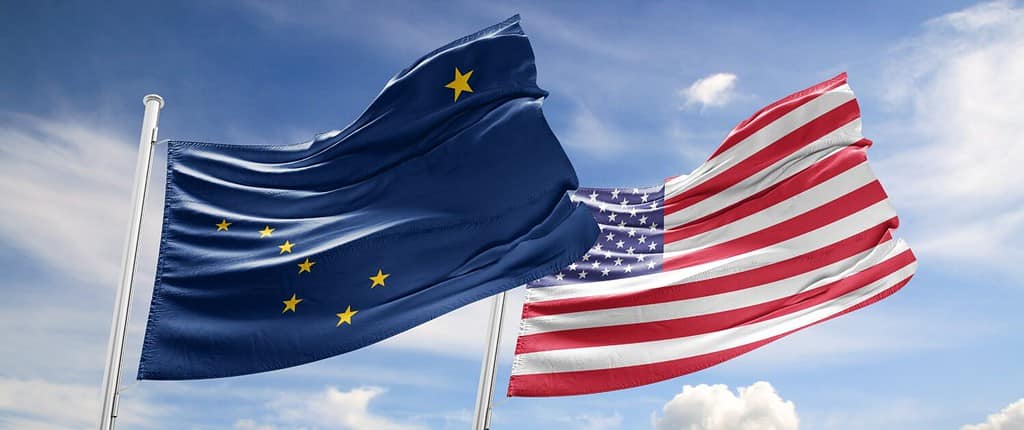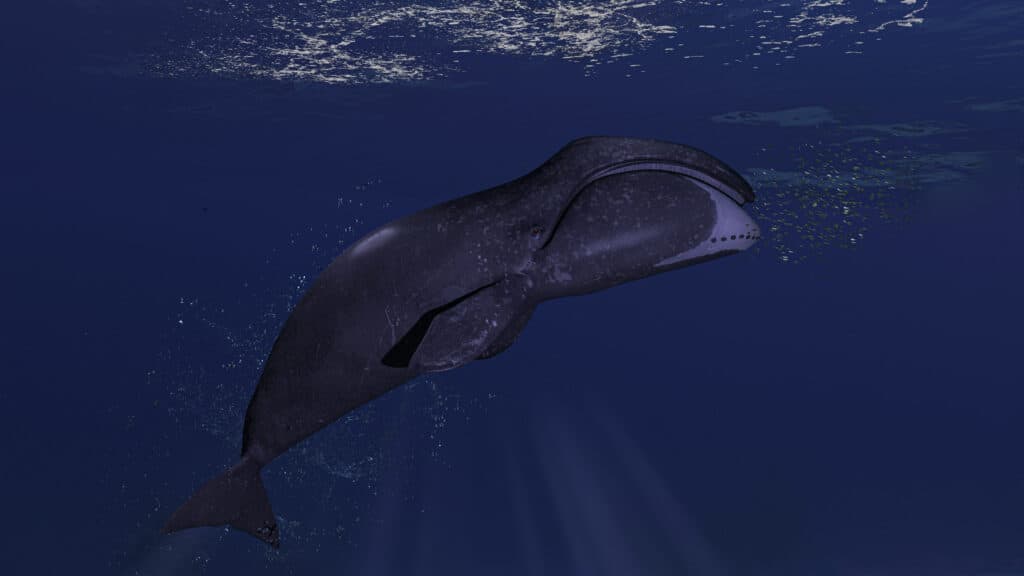Alaska is the 49th state of the union, joining in 1959, and interestingly, it has no land borders with the U.S. However, this far northern land is full of breathtaking landscapes and wildlife. With so much to say about this magnificent frontier, we will share 84 fun facts everyone should know about Alaska.
Alaskan State Facts

A native 13-year-old contest winner designed Alaska’s state flag.
©Svet foto/Shutterstock.com
- Alaska comes from the Aleutian word alaxsxaq, meaning “great land” or “the mainland.”
- In 1741, Danish explorer Vitus Jonassen Bering discovered Alaska during a trip from Siberia.
- In 1867, America purchased Alaska for $7.2 million from Russia.
- Opposition to the Alaska purchase is referred to as “Seward’s Folly,” named for Secretary of State William Seward, who signed the deal.
- Residents celebrate Alaska Day on October 18, an official state holiday to celebrate the date the United States purchased Alaska.
- In 1927, a native 13-year-old contest winner, Benny Benson, designed the state flag featuring the Big Dipper and the North Star. He told the judges that the blue background evokes Alaska’s blue sky and the forget-me-not, the state flower.
- During WWII in 1942-1943, the Japanese attacked Alaska, taking over Attu and Kiska in the Aleutian Islands. Even more, the residents became prisoners.
- Alaska is the largest state in America. As a result, it is 1,420 miles in length, 2,700 miles wide, and 663,268 mi2 in area.
- The population is 733,406 as of 2023.
- In America, only Vermont and Wyoming have fewer residents than Alaska.
- There are two time zones in Alaska: Alaska Time and Hawaii-Aleutian Time.
- The only way to get to Juneau, Alaska’s capital, is by air or sea.
- The largest city, Anchorage, has 291,247 residents as of 2020.
- Most of the state is inaccessible by car, and so only 20 percent is reachable by road.
- Seafood and fishing industries are the state’s largest private employers.
- The average temperature is 40 to 60 degrees Fahrenheit during the summer and 0 to -30 degrees Fahrenheit during the winter months.
- Dog mushing, for instance, the annual Iditarod, is the official state sport.
- The state mineral is gold.
- The state gem is jade.
Geographical Facts

Denali is the tallest mountain in North America.
©evenfh/Shutterstock.com
- Glaciers cover nearly 5% of the state.
- The largest glacier accessible by road is Matanuska Glacier.
- There are 34,000 miles of shoreline, which includes the surrounding islands.
- A third of Alaska is within the Arctic Circle.
- Tongass is the largest national forest in the country, with 17 million acres.
- Alaska is home to seven of the nine largest national parks in the country.
- The largest national park in America is Alaska’s Wrangell-St. Elias National Park and Preserve with 13 million acres.
- Twelve of the 13 highest mountains in the country are in Alaska. Mount Whitney in California is the thirteenth.
- The highest point is Denali at 20,310 feet.
- Alaska is home to 3 million lakes; therefore 40 percent of the country’s surface is water.
- Iliamna Lake is the largest lake.
- The longest river in Alaska and Yukon is the Yukon River; additionally, it is the third longest in North America.
- Alaska is the land of volcanoes with over 130, and experts consider 90 active.
- Southern Alaska has the fastest-moving underwater tectonic faults in the world.
- The largest earthquake ever recorded in North America was in 1964 in Prince William Sound, registering 9.2 on the Richter scale with a duration of over 4 minutes. Scientists recorded over 10,000 aftershocks.
- In 1968, The Atlantic Richfield Company and Humble Oil and Refining Company discovered massive gas and petroleum reserves on the North Slope.
- The largest North American oil field is in Prudhoe Bay, the site of the 1968 discovery.
- Nearly 488,000 barrels of oil a day, as of 2021, are pumped over 800 miles through the Trans-Alaska Pipeline from Alaska to Valdez.
- The main mineral export is zinc.
Wildlife Facts
Mammals and Birds

Alaskan Malamute
dogs are the oldest domesticated breed in the world.
©freevideophotoagency/Shutterstock.com
- Moose are the state land mammal.
- Alaskan moose may grow to 1,600 pounds and are indeed the largest animal of its species in the world.
- Moose travel up to 35 miles an hour.
- Moose antlers may exceed six feet in width.
- Both male and female caribou have antlers.
- In North America, domesticated caribou are reindeer.
- By 1900, Alaskan muskoxen were hunted to extinction in Alaska, but in 1930, officials reintroduced the animals to Alaska by importing them from Greenland.
- The only cat native to Alaska is the lynx.
- Wood frogs are the only frogs that live north of the Arctic Circle.
- Polar bears are protected under the Marine Mammal Protection Act. Additionally, they are the only bear species considered to be marine mammals.
- Alaska’s polar bear population is between 4,000 to 7,000. Bering Land Bridge National Preserve and Cape Krusenstern National Monument report them living nearby.
- Kodiak bears are the largest subspecies of brown bear, males reach over 10 feet tall when standing, 5 feet when on all fours, and weigh up to 1,500 pounds.
- Alaskan brown bears (Kodiaks) expertly salmon fish in streams, as a result, they may catch up to 30 a day.
- Alaskan Malamute dogs are the oldest domesticated breed in the world. Indigenous people, the Inupiaq, bred them around 3,000 years ago, and they are the state dog.
- Most of the northern fur seals in the world breed in the Pribilof Islands.
- The state bird, the willow ptarmigan, changes color from brown to white in winter as a form of camouflage.
- Arctic Terns annually travel as far as Antarctica, one of the longest migrations of any animal on earth.
Fish

Bowhead whales live for over 200 years and have the most enormous mouths of any whale.
©iStock.com/bbevren
- Alaskan salmon is very nutritious because they are an excellent source of protein and contain all essential amino acids.
- The largest salmon caught with a rod and reel was in the Kenai River at 97.5 pounds.
- There are five species of salmon, including pink, chum, sockeye, coho, and chinook, the state fish.
- Humpback whales travel 3,100 miles during their annual migration.
- Bowhead whales are the state marine mammal.
- Southeastern Alaska has Great White Sharks.
Random Facts

The Alaskan bull moose can get up to 1600 pounds.
©JT Fisherman/Shutterstock.com
- About 52% of the population is male, more than any other state in America.
- Utqiagvik, AK, doesn’t see the sun from January 23 to November 18, thanks to the city’s location near the Arctic Circle
- Alaskan natives enjoy Akutaq, an ice cream with cooked fish, tallow, and berries.
- Ranch dressing originated in Alaska in 1949 by Steve Henson, a plumber living in Anchorage.
- Snow goggles existed thousands of years ago because Yupik and Inuit natives created them to prevent snow blindness.
- Aleut and Alutiiq people invented kayaks, Inuktitut for “hunters boat,” over 5,000 years ago for hunting on the sea.
- Vegetables and fruits grow larger here due to 20-hour daylight days.
- Alaska doesn’t have sales tax.
- Residents are paid to live here; the money comes from Alaskan mineral royalties.
- Russia is only 55 miles away from mainland Alaska.
- Alaska is the only eastern hemisphere state in the union.
- Alaska has 114 seaplane bases.
- Anchorage has the fifth busiest air-freight airport by tonnage in the world.
- Anchorage, AK, is a popular refueling stop for international flights due to its geographical location.
- Movies shot in Alaska include “Into the Wild,” “Big Miracle,” and “The Thing.”
- The Northern Lights are visible more than 240 days a year in Fairbanks.
- Fireweed blooms from the bottom up, which signals snowfall will come within six weeks, according to Alaskan legend.
- The state insect is the four-spot skimmer dragonfly.
- The smallest town in Alaska is Kupreanof, with a population of 20 people.
- Alaska’s average annual snowfall is around 209 inches.
- There is an “Alaska Triangle” because people annually disappear between Anchorage, Juneau, and Utqiagvik.
- Alaska’s population includes 16% native residents.
- Waking a bear to photograph it is illegal in Alaska.
In Conclusion
There are so many fascinating facts about this great state, but these are fun facts everyone should know about Alaska.
The photo featured at the top of this post is © jet 67/Shutterstock.com
Thank you for reading! Have some feedback for us? Contact the AZ Animals editorial team.






